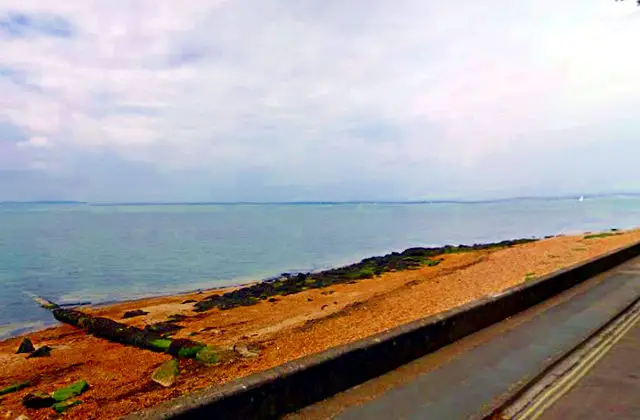Thanks to Luisa Hillard for this latest news from East Cowes. Ed
East Cowes is ‘up-and-coming’ and is undergoing regeneration to transform it into a Destination, famous for more than just Osborne House. Unfortunately, for many years (probably more than a century) there has been an intermittent smell in the mouth of the Medina River which, no matter how attractive the town is, makes it more a case of infamous.
It’s a bit like being a classic Hollywood heart-throb with an embarrassing digestive complaint. No one wants to sit next to them at the dinner table. No matter how attractive, or witty.
So what causes this distinctive smell? The question – is it seaweed or sewage? – has been debated for a long time and is even documented in historical records.
The current view
The current official view is that the smell is due to rotting seaweed, on the ecologically important mud flats, releasing sulphurous gases.
However, this may not be the whole picture. What we also know is:
- Not all boats in the Medina are emptying their holding tanks responsibly and pump out into the river, or even discharge directly.
- During heavy rainfall and flooding the pumping station at Albany Green can become overwhelmed and discharge a mix of sewage and surface run-off directly into the Medina, although it must be stressed that this is a rare occurrence.
- Some of the pipes spilling into the Medina are unidentified (from private sewerage systems) and not under the regulated care of Southern Water.
Fight Against Environmental Contamination of Estuaries and Seafronts (FAECES)
In the summer of 2014 a group of local residents started documenting what they believed to be sightings of sewage in the Medina, some of these floating slicks containing what appeared to be sanitary products.
Each sighting and smell has been reported to the Environment Agency, but could not be confirmed due to the inevitable delay in investigation.
Michael Douse, an East Cowes resident says,
“Residents formed a campaign group called Fight Against Environmental Contamination of Estuaries and Seafronts (FAECES) with the aim of getting regular testing of the water quality and enforcement where sewage-discharging pipes were identified.
“It was decided that gaining DEFRA Bathing Water Designation for the East Cowes beach would be the best way forward to achieve these aims and finally get an answer to the question seaweed or sewage? It might even lead to an improvement.”
Support of local and county council needed
The application process was started, but to be successful it required the support of both the Town Council and County Council.
Luisa Hillard, County Councillor for East Cowes says,
“I was able to secure the support of the Isle of Wight Council for designation on one condition – that the Town Council take responsibility for notifying the public of any water quality failures.
“This would usually be the responsibility of Environment Officers but this local service was lost when the Town Council decided not to contribute towards their cost.”
Residents’ plan supported
In April 2015 the residents presented their plan to the Town Council and were gratified when a decision of “full support” was reached. This meant that the application could go ahead and had a chance of success.
Local business owners who are members of the East Cowes Business Association (ECBA) could see the benefit and wrote a letter to the Town Council in support of the application.
Simon Craddock, the ECBA Chairman says,
“Bathing water designation is important because East Cowes wants to be a destination in its own right and not just roads that customers of Red Funnel drive though to get the ferry. A Bathing Water Quality Beach will be a major asset to the town, both for residents and businesses alike.”
Second summer survey
Following the announcement of support from the Town Council volunteers spent the summer months conducting surveys of the type and number of beach users to prove that people are coming into contact with the water, which is a requirement of the application.
It is not just swimmers and paddlers, but fishermen, dinghy sailors, crabbers and even dog walkers. And yes, people do swim in the waters at East Cowes.
Town council u-turn
In July 2015 the issue of bathing water designation came back onto the Town Council agenda. They agreed to pay for some water quality testing in advance of (and separate to) the application process and successful designation, but “resolutely declined to take on any other responsibility in relation to this matter”.
This U-turn came as a shock to the many volunteers who had spent so much time and effort on the application, based on what they had been assured was ‘full support’.
Complex issues surround designation
The issue of bathing water designation is complex, which might explain why there appears to be some confusion. Should the application be successful and the Town Council honour their original and still-valid agreement of “full support” their responsibilities would include the following (as officially told to the Town Council in June 2015):
- Display the Bathing water classification at the information point on the esplanade. This information would be provided by either DEFRA or the Environment Agency.
- Display the weekly results on the Town Council Website, or provide a link to the Environment Agency’s Website.
- If any sample (taken by the Environment Agency) should fail during the bathing season, the Town Council would have to display signage along the esplanade at access points to the beach informing the public of the water quality failure and this signage would remain in place until further clear samples are taken.
It has been proposed that the Town Council’s recently appointed Facilities Officer oversees the change of signage, i.e. hangs the warning signs if needed. Normally this responsibility would be carried out by Isle of Wight Council Environment Officers, but the Town Council declined to pay for this discretionary service and therefore only receives only the statutory minimum.
No cost to the town council
If the application is successful, the water quality testing is undertaken and paid for by the Environment Agency so there is no cost to the Town Council.
This begs the question: what form will this ‘full support’ take, if not financial? And yet there is resistance to the project by some within the Town Council, despite the ‘full support’ resolution to which they should be legally bound.
Inaccurate information from the Mayor
In the October edition of the East Cowes and Whippingham Magazine the current Mayor, Margaret Webster, incorrectly states that supporting the designation gives the Town Council full responsibility for waste removal from the beach. In actuality, beach cleaning sits (and will sit) firmly with the Isle of Wight Council, as the landowner.
Cllr Webster then goes on to claim that the vulnerability of East Cowes to a shipping accident makes the responsibilities associated with supporting the project too risky, which suggests that Cllr Webster thinks that the Town Council would somehow be expected to clean up an oil spill or wreckage. Which is not the case, at all.
How shipping disasters are even remotely related to the responsibilities outlined above, (i.e that the Town Council erect a couple of warning signs if sewage bacteria are detected) is a mystery, but it proves that misinformation and misunderstandings are threatening what should be a straight-forward, low risk task for the Town Council to take on.
A task which will allow East Cowes to apply for designation as a bathing water beach and which might, finally, help to answer the smelly question and maybe even get it sorted.
Full support must mean exactly that
It has been requested that this issue is on the Town Council agenda for October before the deadline for submission of the application passes and the opportunity to achieve bathing water designation, with all of the benefits that will bring, is missed.
‘Full support’ for bathing water designation must mean exactly that.





